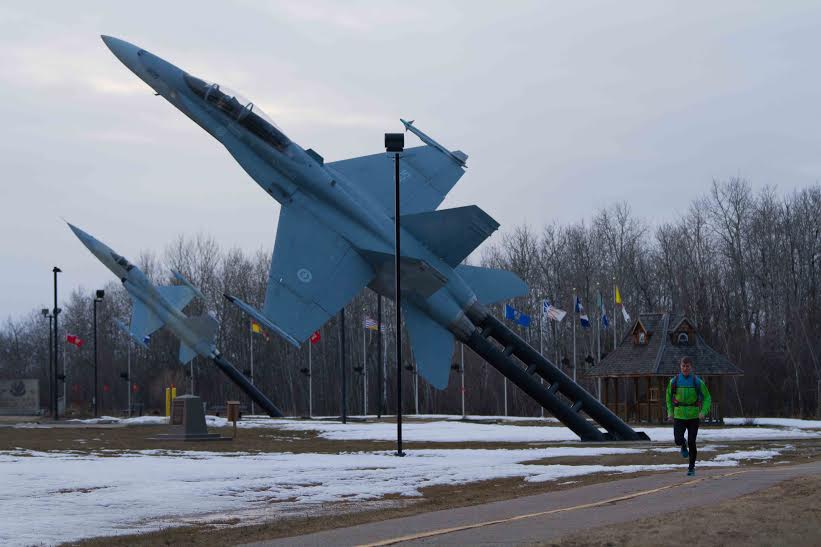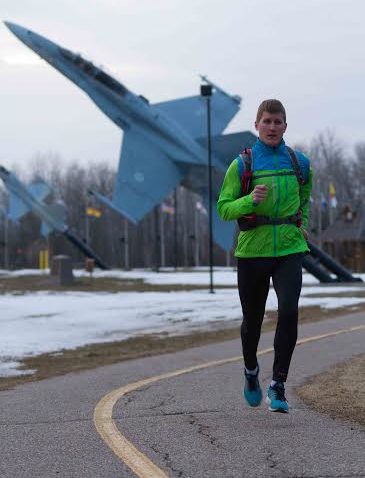Stories from the run commute: “I watch fighter jets fly above me on my daily run”
When Matt Setlack runs to work, he regularly looks up to see fighter jets above him.


Matt Setlack has some pretty crazy stories from the run commute. Running along a trail in Cold Lake, Alberta, his ears are blasted with the sounds of fighter jets overhead. When he looks up, CF-18 jets zoom above him in the sky. They are fast. And loud. But at least their speed is enough to motivate a runner running in the dead of winter through the northern Alberta chill.
Matt Setlack is married to Emily Setlack, a Canadian elite runner who is having a big moment as she makes her comeback on the Canadian running scene. Emily just won the half-marathon championships in Calgary after keeping a low profile for awhile. Matt Setlack is a wicked-fast runner himself holding a 15:13 5K PB, a 32:22 10K PB and a 1:11:28 half.
RELATED: Behind the scenes of Emily Setlack’s killer comeback
To get those speedy times, he gets in a lot of his mileage by running to and from his work at Cold Lake’s Canadian Forces Base where he works as an aerospace engineer leading teams of engineers, designers and technicians as they work on and test the jets. This Alberta base is one of two homes to fighter jet planes in Canada and so Setlack’s running experiences of seeing these planes in action are a rarity. It’s very likely that he’s one of the only runners in the country who regularly sees CF-18 fighter jets fly above him as he runs.
 “There are usually CF-18 Hornet fighter jets flying overhead while I am running. Although they are very loud, it is also exciting to see them fly by,” he says. As seasoned runners know, one of the best parts of running close to home is that dotted along the route’s bends and turns are places with significant memories tied to them. For Setlack, seeing the fighter jets reminds him of a time when he got to fly in one. “It was one of the most exhilarating experiences of my life so far,” he says. As he gets closer to work, he zooms past a jet propped up on display and thinks about how he helped put it there.
“There are usually CF-18 Hornet fighter jets flying overhead while I am running. Although they are very loud, it is also exciting to see them fly by,” he says. As seasoned runners know, one of the best parts of running close to home is that dotted along the route’s bends and turns are places with significant memories tied to them. For Setlack, seeing the fighter jets reminds him of a time when he got to fly in one. “It was one of the most exhilarating experiences of my life so far,” he says. As he gets closer to work, he zooms past a jet propped up on display and thinks about how he helped put it there.
The route he takes runs along Millennium Trail where he runs the seven or eight kilometres one way to work and then back again at the end of the day. Generally speaking, Setlack is a fairly motivated guy but even still, running throughout the winter in a frigid place like Cold Lake, it can be a test. In the extreme sub-zero temperatures in mid-winter, most who live in the small town give up on their fitness (-30 C doesn’t make for a very active community). But not seeing others out can make the daily runs a mental battle. “If you were running with me, you would rarely see anyone else out running but you would see hundreds of jacked-up trucks spewing black smoke out of their exhaust pipes while accelerating unnecessarily fast away from traffic lights,” says Setlack. “It can be very challenging run commuting when you go for weeks or months without seeing anyone outside doing any sort of physical activity.”
RELATED: Stories from the run commute: “My run commute led to a career change”
RELATED: Stories from the run commute: I lost 100 pounds by running to work
With that comment, it shouldn’t come as a surprise that part of his run commuting is for environmental reasons: why create extra pollution if you don’t have to? He and Emily choose to share a vehicle for this reason. That choice also means that running to work is his only means of commuting. “We do not believe it is necessary for two people to have two vehicles in such a small town,” he says via email. “One of the major ‘must’ criteria that Emily and I used when buying a house was the distance it was from work. It needed to be close enough to run to work.”
When running to work is the only way to commute, the run isn’t optional. Since run commuting, Setlack says that there have been fewer missed runs. Also, a significant portion of his training is taken care of. To round it out, he’ll add in other runs and workouts plus his favourite cross-training activities namely skiing, rowing, weight lifting or climbing (he actually has a side job as an indoor climbing instructor at the base climbing wall).
The run commute can be quite convincing. It’s often said that running is a lifestyle. Many could make claims that run commuting is too. And it seems to have infinite gains. “When you know you have to go to work, you are not going to miss your run when running is the only way to get there. At the end of the day, no matter how tired you may be or how poor the weather is outside, your only choice is to run,”he says.
Most who are interested in adopting this habit want to know how the technicalities work for each run commuter. In Setlack’s case, he was also inspired by another runner: his friend Jason Furlong. The runner was running to and from work every morning despite -35-degree temperatures. “I thought that if he could do it, then I could do it too,” says Setlack. So then it was just down to the details. He makes it work by leaving his uniform and steel-toed boots at work. Then, every winter, he gets a new outfit of every piece of running gear he needs, and then he brings with him a small backpack with his lunch stored. He’s lucky to have showers at work. That’s it.
“I think run commuting is way easier than people realize and way more people would do it if only they knew how easy it was,” says Setlack. “I would like to encourage people to try run commuting for one week. If you don’t enjoy it, then don’t do it but at least try it.”
His list of payoffs to back up that statement is pretty long: there’s the environmental gains, the time saving element, the fact that it gives him time to reflect on his day and it gives him more energy in return. All in all, it just feeds him more than a more traditional method would. “It takes 10-15 minutes to drive to work and 35-40 minutes to run. I would rather spend my time running than sitting in a car driving.” Plus, as he points out, it’s just a healthy decision.
“It makes you feel good,” Setlack says. “The ironic thing about running is that generally it gives you more energy rather than less energy. Lethargy breeds lethargy and vice versa.”


